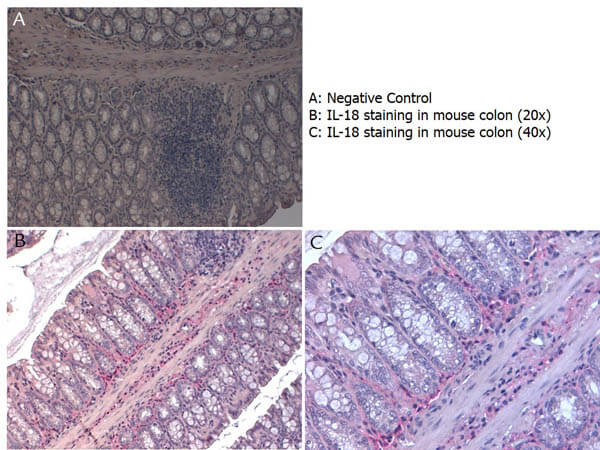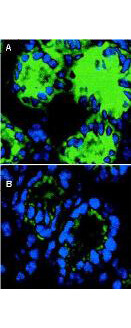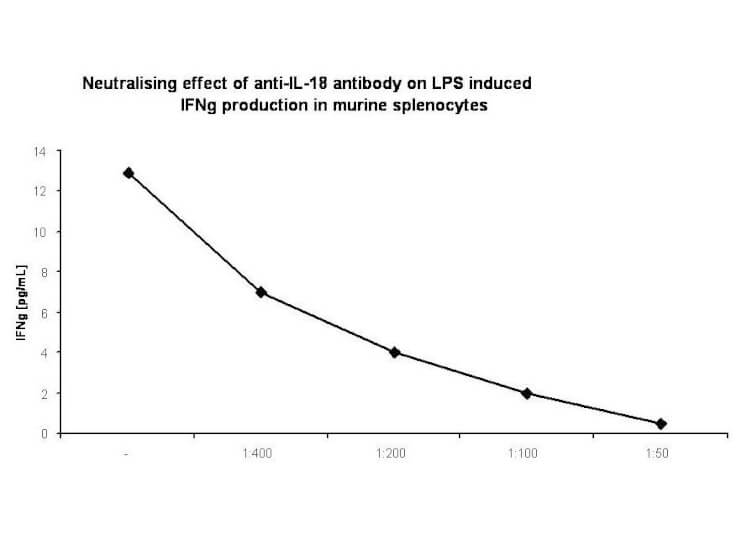Mouse IL-18 Antibody
Rabbit Polyclonal
$50.00 to US & $70.00 to Canada for most products. Final costs are calculated at checkout.
Background
Interleukin-18 (IL-18) is a member of the IL-1 cytokine family and was initially identified as an Interferon-g (IFN-g) inducing factor (IGIF). The IL-18 gene was originally cloned from liver cells and has since been shown to be produced by activated monocytes/ macrophages, Kupffer cells, keratinocytes, glucocorticoid-secreting adrenal cortex cells, osteoblasts and dendritic cells. IL-18 is a 24 kDa, non-glycosylated polypeptide that lacks a classical signal sequence and possesses a structure recognizably similar to IL-1. IL-18 is synthesized as a bio-inactive propeptide that undergoes proteolytic cleavage by either ICE (interleukin-1 beta converting enzyme) or another caspase to generate a mature, bioactive, 18 kDa molecule. In both the mature and propeptide forms, IL-18 shows 64% aa sequence identity from mouse to human. IL-18 does not appear to show any primary sequence similarity to any other known cytokines. Rat IL-18 has also been isolated, and found to be 194 aa in length with a 91% aa sequence identity to mouse IL-18. Human IL-18 has been found to induce the production of IFN-g and GM-CSF while inhibiting the production of IL-10 by PBMC. With respect to human T cells, IL-18 enhances Th1 cytokine production and stimulates cell proliferation via an IL-2-dependent pathway. Human IL-18 can also inhibit the synthesis of IgE by B cells. Thus, IL-18 plays an important role in immunological and inflammatory reactions. Currently, the bioactivity of human IL-18 is often determined by its capacity to augment the levels of IFN-g produced by T cells as measured in tissue culture supernatants.
Product Details
Target Details
Application Details
Formulation
Shipping & Handling
This product is for research use only and is not intended for therapeutic or diagnostic applications. Please contact a technical service representative for more information. All products of animal origin manufactured by Rockland Immunochemicals are derived from starting materials of North American origin. Collection was performed in United States Department of Agriculture (USDA) inspected facilities and all materials have been inspected and certified to be free of disease and suitable for exportation. All properties listed are typical characteristics and are not specifications. All suggestions and data are offered in good faith but without guarantee as conditions and methods of use of our products are beyond our control. All claims must be made within 30 days following the date of delivery. The prospective user must determine the suitability of our materials before adopting them on a commercial scale. Suggested uses of our products are not recommendations to use our products in violation of any patent or as a license under any patent of Rockland Immunochemicals, Inc. If you require a commercial license to use this material and do not have one, then return this material, unopened to: Rockland Inc., P.O. BOX 5199, Limerick, Pennsylvania, USA.



